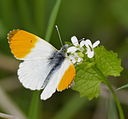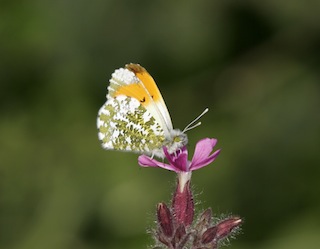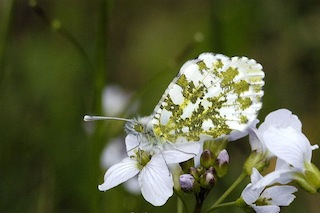 Orange-tips can be seen on the wing along the hedgerows and verges as the weather becomes warmer in mid- to late spring.
Orange-tips can be seen on the wing along the hedgerows and verges as the weather becomes warmer in mid- to late spring.
Photo: Andreas Eichler
Scientific name: Anthocharis cardamines
Cornish name: Tikki-dui (the name for butterflies in general)
Conservation status: No conservation designation
 The Orange-tip, which flies in the spring and early summer, is a widespread butterfly, with a range that includes Europe, Ireland, parts of Scandinavia, and the Middle East and Asia. The female generally emerges later than the male, and has a grey-ish rather than orange wing-tip, which can cause superficial confusion with other white butterflies. Both sexes however have a characteristic marbled greenish pattern on the hind-wing undersides.
The Orange-tip, which flies in the spring and early summer, is a widespread butterfly, with a range that includes Europe, Ireland, parts of Scandinavia, and the Middle East and Asia. The female generally emerges later than the male, and has a grey-ish rather than orange wing-tip, which can cause superficial confusion with other white butterflies. Both sexes however have a characteristic marbled greenish pattern on the hind-wing undersides.
There are several potential foodplants for the caterpillars, but the species seems in particular to favour Cuckooflower, Garlic and Hedge Mustard, as well as some other members of the Crucifer family. Females almost always lay only a single egg on a flower, probably to reduce competition for the food provided by the seedpods. The pupae overwinter and emerge the following spring: Orange-tips produce a single generation each year.

Did you know…?
…females use a pheromone to mark flowers where they have laid an egg, to put other females off from using the same flower.
…Orange-tip caterpillars are known to be cannabilistic
More information and references:
Mansell, E. and Newman, L.H., 1968. The Complete British Butterflies in Colour. Ebury Press and Michael Joseph, London.
Wacher, J., Worth, J. and Spalding, A., 2003. A Cornwall Butterfly Atlas. Pisces Publications, Berkshire.
Published: May 2013
Author: Amanda Scott
Photos: male – Armin Kübelbeck; female – James Lindsey at Ecology of Commanster
